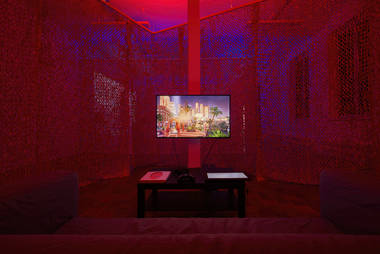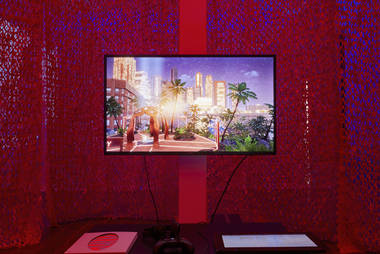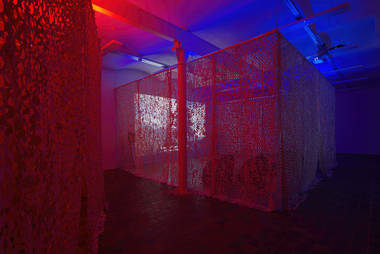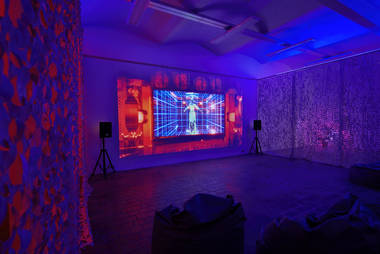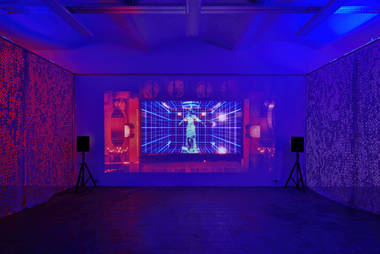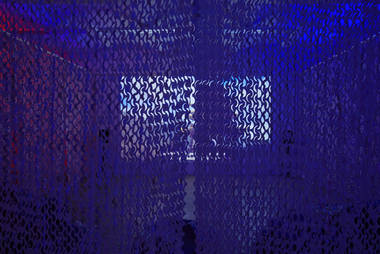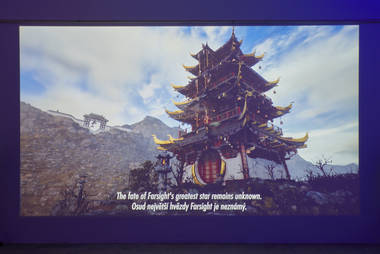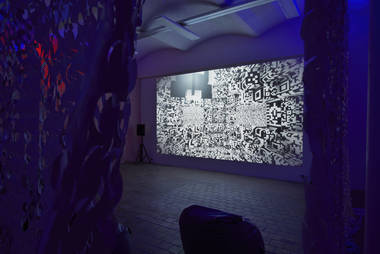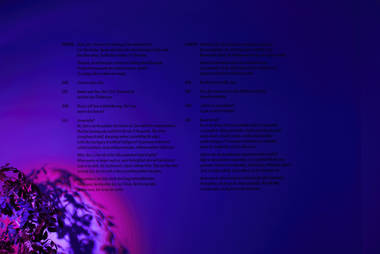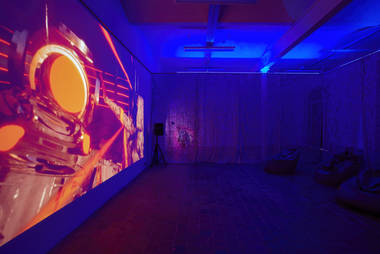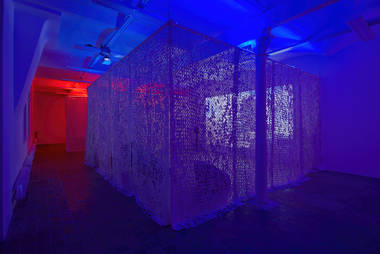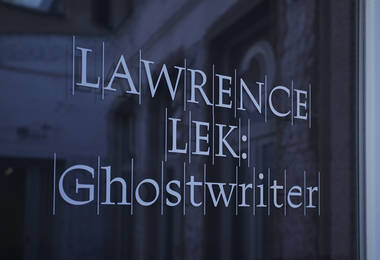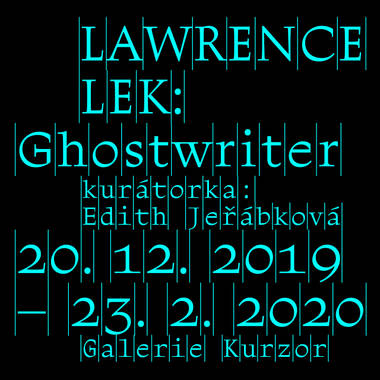Lawrence Lek: Ghostwriter
20. 12. 2019 – 23. 2. 2020
opening: 19. 12. 2019
screening of the film AIDOL starts at: 12.00,
1.30 pm, 3.00 pm and 4.30 pm
curator: Edith Jeřábková
Before we talk about AIDOL, your recent feature-length CGI film made using gaming software, I wanted to ask about the whole “saga” of the relationship between Sinofuturists and Bio-Supremacists, as you created these terms for AI and humans in the near future. This derives from your film Sinofuturism (1839-2046 AD) (2016), a portrait of invisible but existing processes, which we can distinguish better now as the surveillance capitalist economy represented, for example, by Tencent Holdings in China. But you developed some of the main players of the film AIDOL even earlier, such as the Farsight eSport games company in Geomancer (2017). How much do you anticipate when you develop your screenplays? And how did the whole series start? Can you already see what direction you will take after AIDOL?
Farsight is the fictional AI startup that creates the eponymous superintelligent weather satellite in Geomancer, which is set in 2065. Since I also question the notion of creativity today, after I made the film, I wanted to rethink my own status as the author of the work. What if, in fact, my role as an artist between 2017 and 2065 would be to fulfil the fictional storyline of the film itself? That way, I could think of myself as a content creator for this future corporation, instead of the traditional romantic notion of the artist-as-author. One of the premises of Sinofuturism was that copying, rather than originality, can bring forth a new notion of creativity in an age of algorithmic capitalism and artificial intelligence. I therefore carefully composed subsequent works such that they could fit into the fictional world in which Farsight has come to dominate the creative industries. These projects take various forms, including the VR installation Play Station (2017), the video game 2065 (2018), and of course, the feature CGI film AIDOL (2019).
Sinofuturism itself was written and made when I was researching and writing the script for Geomancer. Essentially, I noticed striking similarities between how both AI and Chinese industrialisation are portrayed, both in their positive and negative aspects. From a predominantly Western neo-imperialist perspective, Chinese industrialisation and AI are equated with cheap labour and automated workforces, and are seen as a threat to entrenched forms of capitalist domination. Yet some people see the emerging superpower as something to be welcomed. I noticed that the very forms of replication Chinese culture uses – copying, labour, computing, studying, and so on – form the basis of the subset of AI known as deep learning. Therefore, in a similar manner to how Gulf Futurism and Afrofuturism attempt to assert new approaches to non-Western technological cultures, I used AI as the avatar and symbol of Sinofuturism in my video essay.
There is always space devoted to the position of art in your films. One example would be “art” as a very human thing forbidden to AIs, like the AI Geo experiences with their desire to be a songwriter, who does not want to predict, but create. In AIDOL, the life and working conditions of the artist – the pop-star Diva – directly depend on her “Life” pills and the automation of her songs. Diva and Geo break the rules and make a song together, which becomes viral, and so the humans no longer have a monopoly on art. The death of Diva confirms the cliché and bestows immortality on her. Do you believe that art can play such a key role in future interconnections between humans and technologies?
I think these interconnections are already being made, except that the state of automated creativity has not reached a point where the machine itself has agency. But this isn’t the only point. I use the subject of art in my work in a broad sense, not only as this sacred field in which it is exclusively a human product, but to explore the socio-economic basis of its production. As I mentioned earlier, sometimes I see the role of a contemporary artist like myself as being a content creator for cultural institutions. Of course, I would like to believe that art can transcend the conditions of its production, but as a musician I also realise how dependent what I produce is on the technologies and the audiences, both human and nonhuman, that consume my work.
On the topic of mortality and immortality – in your interview with Steve Goodman you were talking about parallel death conceptions in AIDOL and Geomancer, about the planned obsolescence of products made with “a death in mind”, through which the producer governs the life of their goods, the market and the users. This is stated as the legitimate death of Geomancer, who is an adolescent weather surveillance AI experiencing a non-AI state of consciousness, which is a more psychological turnover. But there is also the hype death as you said. You have envisaged Sinofuturism as a movement, which became hyped, and then you wrote Geomancer to embrace the fact of its obsolescence. Why is obsolescence such a topic for you?
In AIDOL, Diva’s greatest fear is to be forgotten. The writer and psychologist Ernest Becker’s book The Denial of Death (1973) proposes that all of humanity’s cultural activity is predicated upon the need for immortality. Not biological immortality, but the desire not to be forgotten. Books, music, films, monuments, architecture, even families and children – all of these are part of this continuous struggle not to fade away. Sometimes I’m asked if I think of my audience when I create my work. Again, the romantic notion is that the artist creates purely for themselves. However, I thought about this a lot, and I realised that the vast majority of works I love are by creators who are either dead or have no idea that I exist. From the point of view of that past author, I am part of an unknown audience that they only have contact with through the artefacts and artworks they leave behind. I bring this idea with me whenever I’m making something, and I use new works to re-evaluate the significance or insignificance of things I’ve done before. This is what I did several times, where the AIs in Geomancer from 2065 have watched my video essay Sinofuturism from 2016, and have used it as inspiration for a nonhuman-led artistic movement.
AIDOL (AI + idol) speaks a lot about today’s music industry. The film is also structured like an album, with chapters corresponding to tracks. One is also unsure if in the product hierarchy the film is made for the songs or vice versa. You are also a musician. Could you mention some of the ways in which AI is intertwined with contemporary music trends and tastes, and how it is imprinted in the movie?
AIDOL has music as both its subject matter and its medium. The work itself is meant to create an ambiguity as to whether the entire film is a promotional exercise from Farsight, or whether it’s a film about Diva’s comeback. Since the film itself is divided into thirteen tracks, like an album, it could be read as a feature-length music video – like Prince’s Purple Rain – or a narrative tragic drama. As for AI, of course there are many fantasies about how automation can be applied to music-making to create sublime works of art. However, the way it’s used right now in commercial terms are the opposite of this. Some startups are exploring how to create copyright-free music to provide soundtracks that create particular moods or emotions, but don’t require the producer of the video or video game to pay any royalties or licensing fees to music creators themselves. It’s purely an exercise in economic optimisation. Other streaming platforms use smart algorithms – weak AI, essentially – to predict listener preferences in order to create a seamless, frictionless experience for the audience. In both cases, it’s like music disappears further and further into the background. I’m interested in bringing it back to the foreground, not just as an aesthetic medium, but as a field that embodies the rupture that technology creates in culture.
Your films can be seen as hyperstitions, since they force reality to mix with your fiction. An example would be how the Sinofuturist movement became quite real, or when we talk about all the places, movements, players, figures and plots, and how they mix with our reality. But a lot is shaped from reality and our history, be this Farsight Corporation, Call of Duty, AlphaGo, and so on. The proximity of reality to the genre of fiction causes these ongoing mutations. Does your visual concept also follow this? You model most of the environments vividly on reality. A good example is the location in AIDOL, which is very much like a casino and theme park in Genting Highlands, Malaysia.
I always try to ground my fiction in reality. I think that the more speculative the scenarios an author creates, the more they need to integrate details and nuances that can only come from close observation of how strange and unexpected the real world actually is. So over the past few years, I’ve actively tried to observe more of the environments I used to take for granted, whether that’s Genting Highlands in Malaysia or Marina Bay in Singapore. These kinds of neoliberal architectures – casinos and shopping complexes – are embedded in landscapes that are themselves shaped by geology and human engineering. Both of them also reflect the hybrid nature of the worlds I’m trying to create, where neither history nor futurity, neither virtuality nor physical reality, take precedence. Like AIDOL and Geomancer themselves, my experience of the world is a non-linear process that depends both on my immediate perception of a place as well as my memories of it.
Edith Jeřábková, Lawrence Lek
The programme of the Center for Contemporary Arts Prague receives support from the Ministry of Culture of the Czech Republic, Prague City Council, State Fund of Culture of the Czech Republic, City District Prague 7
partners: Kostka stav
courtesy: Sadie Coles HQ
media support: ArtMap, jlbjlt.net and UMA: You Make Art



